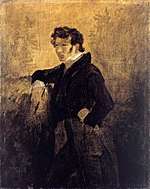Cottbus
Cottbus (German pronunciation: [ˈkɔtbʊs] (![]()
Cottbus/Chóśebuz | |
|---|---|
     From top: View of Cottbus at sunset, The Art-Nouveau façade of the State Theater (1905), The 14th cent. Spremberger Tower, View on the Karl-Liebknecht Str, The library of the Brandenburg University of Technology | |
 Coat of arms | |
Location of Cottbus/Chóśebuz 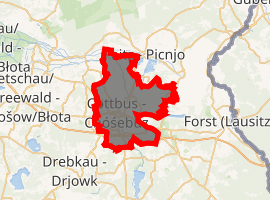
| |
 Cottbus/Chóśebuz 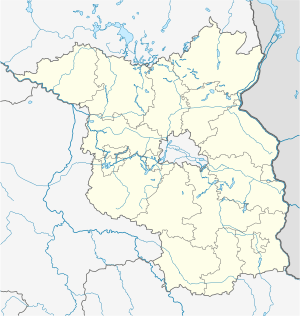 Cottbus/Chóśebuz | |
| Coordinates: 51°45′38″N 14°20′03″E | |
| Country | Germany |
| State | Brandenburg |
| District | Urban district |
| Government | |
| • Lord Mayor | Holger Kelch (CDU) |
| Area | |
| • Total | 164.28 km2 (63.43 sq mi) |
| Elevation | 70 m (230 ft) |
| Population (2018-12-31)[1] | |
| • Total | 100,219 |
| • Density | 610/km2 (1,600/sq mi) |
| Time zone | CET/CEST (UTC+1/+2) |
| Postal codes | 03042-03055 |
| Dialling codes | 0355 |
| Vehicle registration | CB |
| Website | www.cottbus.de |
Spelling
Until the beginning of the 20th century, the spelling of the city's name was disputed. In Berlin, the spelling "Kottbus" was preferred, and it is still used for the capital's Kottbusser Tor ("Cottbus Gate"), but locally the traditional spelling "Cottbus" (which defies standard German-language rules) was preferred, and it is now used in most circumstances. Because the official spelling used locally before the spelling reforms of 1996 had contravened even the standardized spelling rules already in place, the Standing Committee for Geographical Names stress their urgent recommendation that geographical names should respect the national spelling standards. A citizen of the city may be identified as either a "Cottbuser" or a "Cottbusser".
Names in different languages:
- Czech: Chotěbuz
- German: Cottbus
- Latin: Cotbusium
- Polish: Chociebuż
- Lower Sorbian: Chóśebuz
- Upper Sorbian: Choćebuz
- Yiddish: קוטבוס, romanized: Kutbus
History
Duchy of Poland 1002–1025
![]()
![]()
![]()
![]()
![]()
![]()
![]()
![]()
![]()
![]()
![]()
![]()
![]()
The settlement was established in the 10th century, when Sorbs erected a castle on a sandy island in the River Spree. The first recorded mention of the town's name was in 1156. In the 13th century German settlers came to the town and thereafter lived side by side with the Sorbs. In the Middle Ages Cottbus was known for wool, and the town's drapery was exported throughout Brandenburg, Bohemia and Saxony. In 1445 Cottbus was acquired by the Margraviate of Brandenburg from Bohemia. In 1514 Jan Rak founded the Universitas Serborum, a Sorbian gymnasium, in the city. In 1701 the city became part of the Kingdom of Prussia. It was also ruled by Saxony between 1807 and 1813. In 1815 the surrounding districts of Upper and Lower Lusatia were ceded by the Kingdom of Saxony to Prussia. During World War II, Cottbus was taken by the Red Army on 22 April 1945.
From 1949 until German reunification in 1990, Cottbus was part of the German Democratic Republic (East Germany).
Demography
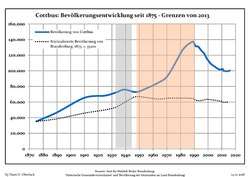 Development of population since 1875 within the current Boundaries (Blue Line: Population; Dotted Line: Comparison to Population development in Brandenburg state; Grey Background: Time of Nazi Germany; Red Background: Time of communist East Germany)
Development of population since 1875 within the current Boundaries (Blue Line: Population; Dotted Line: Comparison to Population development in Brandenburg state; Grey Background: Time of Nazi Germany; Red Background: Time of communist East Germany)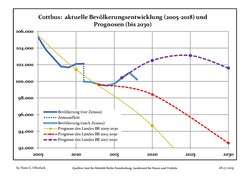 Recent Population Development and Projections (Population Development before Census 2011 (blue line); Recent Population Development according to the Census in Germany in 2011 (blue bordered line); Official projections for 2005-2030 (yellow line); for 2014-2030 (red line); for 2017-2030 (scarlet line)
Recent Population Development and Projections (Population Development before Census 2011 (blue line); Recent Population Development according to the Census in Germany in 2011 (blue bordered line); Official projections for 2005-2030 (yellow line); for 2014-2030 (red line); for 2017-2030 (scarlet line)
| Cottbus: Population development within the current boundaries (2017)[2] | |||||||||||||||||||||||||||||||||||||||||||||||||||||||||||||||||||||||||||||||||||||||||||||||||||||||||||||||||||||||||||||||||||||||||
|---|---|---|---|---|---|---|---|---|---|---|---|---|---|---|---|---|---|---|---|---|---|---|---|---|---|---|---|---|---|---|---|---|---|---|---|---|---|---|---|---|---|---|---|---|---|---|---|---|---|---|---|---|---|---|---|---|---|---|---|---|---|---|---|---|---|---|---|---|---|---|---|---|---|---|---|---|---|---|---|---|---|---|---|---|---|---|---|---|---|---|---|---|---|---|---|---|---|---|---|---|---|---|---|---|---|---|---|---|---|---|---|---|---|---|---|---|---|---|---|---|---|---|---|---|---|---|---|---|---|---|---|---|---|---|---|---|---|
|
|
| |||||||||||||||||||||||||||||||||||||||||||||||||||||||||||||||||||||||||||||||||||||||||||||||||||||||||||||||||||||||||||||||||||||||
Culture and education

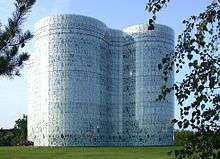
Cottbus is the cultural centre of the Lower Sorbian minority. Many signs in the town are bilingual, and there is a Lower Sorbian-medium Gymnasium and a Sorbian Quarter, but Sorbian is rarely spoken on the streets.
Next to Cottbus is the famous Branitz Park, created by Prince Hermann von Pückler-Muskau after 1845. Schloss Branitz (Branitz Castle) was rebuilt by Gottfried Semper in a late Baroque style between 1846 and 1852, and the gardens Prince Hermann laid feature two pyramids. One of these, the Seepyramide, is in the middle of an artificial lake and serves as his mausoleum.[3]
Cottbus is also home to the Brandenburg University of Technology (BTU) and the maths/science-oriented Max-Steenbeck-Gymnasium, named after the physicist Max Steenbeck.
Every year Cottbus hosts the East European Film Festival.
Cottbus has a football team, Energie Cottbus, that plays in the Regionalliga Nordost. Their home matches are played at the city's Stadion der Freundschaft.
Power generation
There are several lignite-fired power stations in the area around Cottbus (Lausitz). The biggest stations are "Schwarze Pumpe" (1600 MW), "Boxberg" (1900 MW) and "Jänschwalde" (3000 MW).
International relations
Twin towns – sister cities
Cottbus is twinned with:[4]









Notable people
1801–1850
- Gustav Theodor Fritsch (1838–1927), anatomist, anthropologist and physiologist
- Otto Hugo Paul Grottkau (1846–1898) socialist and trade unionist and American journalist
1851–1950
- Reinhold Platz (1886-1966), aircraft designer and manufacturer at Fokker
- Viktoria Schmidt-Linsenhoff (1944–2013), German art historian and professor
1951–1975
- Rudi Fink (born 1958), amateur boxer and boxing coach
- Gabriele Reinsch (born 1963), world record holder discus throwing
- Jens Melzig (born 1965), football player
- Marco Geisler (born 1974), rower
Since 1976
- Janice Behrendt (born 1983), beauty queen and model
- Daniel Musiol (born 1983), cyclist
- Robert Harting (born 1984), discus thrower
- Tony Martin (cyclist) (born 1985), cyclist
- Heiko Schwarz (born 1989), football player
References
- "Bevölkerung im Land Brandenburg nach amtsfreien Gemeinden, Ämtern und Gemeinden 31. Dezember 2018". Amt für Statistik Berlin-Brandenburg (in German). July 2019.
- Detailed data sources are to be found in the Wikimedia Commons.Population Projection Brandenburg at Wikimedia Commons
- Udo Lauer, Fürst Pücklers Traumpark, Ullstein Verlag, 1996, Berlin
- "Städtepartnerschaften". cottbus.de (in German). Cottbus. Retrieved 25 November 2019.
External links
| Wikimedia Commons has media related to Cottbus. |

- Official website (in German, English, and Polish) (Sorbian)
- Homepage of Brandenburg Technical University
- . Encyclopædia Britannica (11th ed.). 1911.
